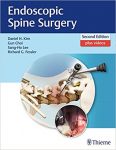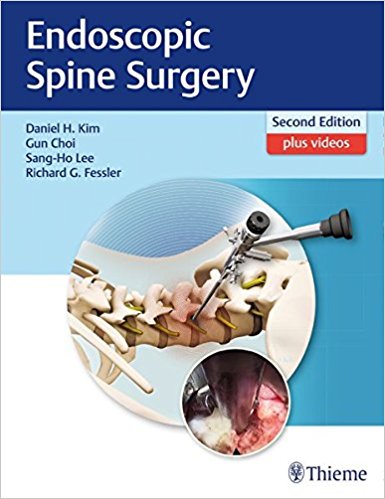 Editors: Daniel H. Kim, MD; Gun Choi, MD; Sang-Ho Lee, MD; and Richard Fessler, MD
Editors: Daniel H. Kim, MD; Gun Choi, MD; Sang-Ho Lee, MD; and Richard Fessler, MD
Publisher: Thieme – 362 pages, with 1,094 illustrations
Book Review by: Nano Khilnani
Endoscopy has been used widely during the last few decades in many specialties of medicine and surgery, but has lagged behind in the medical and surgical management of disorders of the spine, one of the principal components of the human frame.
But that lag has stopped. The advancement of technology has played a good part in fostering the increased use of endoscopy in the treatment of spine problems, particularly through surgery.
The popularity of minimally-invasive procedures has also grown to a substantial extent in various medical disciplines as well as in spine care in the last several decades. The benefits of minimally-invasive surgery are numerous, the main ones being fast functional recovery and short hospital stays, the editors point out in their Preface.
This book has been developed not only for neurosurgical and orthopedic surgeons interested in increasing their knowledge and skills relating to diagnosis and treatment of spine disorders and injuries, but also for other physicians, fellows, residents, and medical students. This book could also be of use to chiropractors, medical device professionals, nurses, and physical therapists.
Seventy-five specialists including the four editors named above in endoscopic spine surgery, from nine countries – Canada, Chile, Germany, India, Mexico, Singapore, South Korea, Thailand, and the United States – authored the 53 chapters of this extensive book on surgeries of the various components of the spine and the different approaches to the procedures involved.
The topics covered in this large book with over 1,000 illustrations are numerous. To give you a sort of rundown of the topical coverage of this very important book and detailed text on endoscopic spine surgery, we provide for your guidance below an alphabetically-sorted list of procedures on the various parts of the spine and the approaches to those procedures:
360-degree endoscopically-assisted minimally-invasive transforaminal lumbar interbody fusion;
Applied anatomy and percutaneous approaches to the cervical lumbar spine; applied anatomy for percutaneous approaches to the lumbar spine; applied anatomy for percutaneous approaches to the thoracic spine.
Cervical laminoforaminotomy with working channel endoscope
Destandau’s technique: interlaminar approach to lumbar diskectomy with canal decompression; direct lateral endoscopic lumbar interbody fusion and instrumentation
Endoscopic anterior cervical diskectomy and cord decompression; endoscopic approaches to thoracic tumors, trauma, and infection; endoscopic / percutaneous lumbar pedicle screw fixation technique; endoscopic radiofrequency denervation for treatment of chronic low back pain;
Endoscopic removal of intradural extramedullary space-occupying lesions; Endoscopic transforaminal lumbar interbody fusion and instrumentation; endoscopic transnasal approaches to the craniocervical junction; endonasal approach to the craniocervical junction; endoscopic transoral approaches to the craniocervical junction
Foramen magnum decompression of chiari malformation using minimally-invasive tubular retractors;
Interlaminar surgical approach for percutaneous endoscopic laser annuloplasty / nucleoplasty
Laparoscope- and endoscope-assisted oblique lumbar interbody fusion
Minimally-invasive microsurgical resection of spinal intradural extramedullary lesions; minimally-invasive tubular decompression for foraminal stenosis
Percutaneous endoscopic cervical diskectomy; percutaneous endoscopic decompressive laminectomy and foraminatomy; percutaenous endoscopic interlaminar lumbar diskectomy;
Percutaenous endoscopic lumbar diskectomy for or with the following approaches and purposes: – extraforaminal approach; with foraminotomy; for migrated lumbar disk herniation; for structural preservation using a technique for L5-51 herniated nucleus pulposis; and with a transforaminal approach.
Percutaneous translaminar and ipsilateral facet fixation technique; percutaneous unilateral biportal endoscopic diskectomy and decompression for lumbar degenerative disease;
Posterior percutaneous endoscopic cervical foraminatomy and diskectomy: case presentation and surgical technique; posterior tubular endoscopic cervical diskectomy; posterior tubular endoscopic cervical foraminatomy and laminectomy
Surgical technique for percutaneous endoscopic laser annuloplasty and nucleoplasty
Three-dimensional spine surgery: clinical application of 3D-stereo-tubular endoscopic systems; thoracoscopic approaches to deformity correction; thorascopic decompression and fixation for thoracic and thoracolumbar junction lesions; thoracopic diskectomy; transforaminal epiduroscopic laser annuloplasty for diskogenic pain;
Tubular endoscopic lumbar diskectomy and laminoforaminotomy; tubular endoscopic lumbar foraminatomy and hemilaminectomy; tubular endoscopic thoracic decompressive laminectomy; tubular lumbar decompressive foraminotomy and laminectomy;
Ultrasonic bone dissectors in minimally invasive spine surgery; unilateral biportal endoscopic decompression for lumbar spinal stenosis
Video-assisted anterior cervical diskectomy and instrumentation; video telescope operating monitor for spine surgery
In addition to the contents found in this print edition, you can watch 64 videos on case studies of actual patients with various pathologies, and learn from technique tutorials online by going to www.MediaCenter.Thieme.com.
Once there, during your book registration process, enter the access code found on the first page of your book. To preview and choose which videos you want to watch and learn from, a list is found in this book right after the Contents pages.
The cervical, coccygeal, lumbar, sacral, and thoracic regions of the spine have subtle microanatomical differences that even an experienced surgeon may not notice because of the narrow endoscopic view. This book contains clear, detailed views of those microanatomies.
There are numerous chapters in this second (2018) edition demonstrating new technologies in spine surgery. An interesting one is chapter 28 entitled Video Telescope Operating Monitor for Spine Surgery on pages 203-207. In this chapter, authors Daniel Drazin and Adam N. Mamelak discuss the video telescope operating monitor (VITOM) also known as an exoscope. Among the features and benefits of using this system are the following:
- It is a rigid rod lens system that looks and functions much like standard telescopes but has a long focal distance of 25 to 30 centimeters
- It is positioned outside the surgical cavity
- It is used with a mechanical or pneumatic scope holder that permits rapid repositioning and refocusing
- Since operative surgical visualization is performed from the monitor, the surgeon is able to sit or stand in a comfortable, arms-fixed position, with minimal strain on his neck or arms, thereby reducing surgical fatigue and endpoint tremor
This is a highly authoritative, detailed and excellent book on endoscopic spine surgery, with almost 1,100 illustrations, making it an ideal and valuable resource to own and use.
Editors:
Daniel H. Kim, MD, FAANS, FACS is the Nancy Clive and Pierce Runnels Distinguished Chair in Neuroscience, Professor and Director of Spinal Neurosurgery and Reconstructive Peripheral Nerve Surgery, and Director of the Microsurgical Robotic Lab, in the Department of Neurosurgery at University of Texas Health Science Center in Houston, Texas.
Gun Choi, MD, PhD is President of Pohang Wooridul Hospital in Pohang, South Korea.
Sang-Ho Lee, MD, PhD is Professor and Chairman of Wooridul Spine Hospital in Seoul, South Korea.
Richard Fessler, MD, PhD is Professor in the Department of Neurosurgery at Rush University Medical Center in Chicago, Illinois







